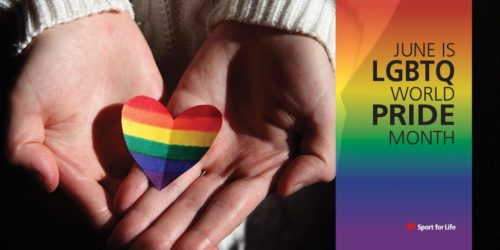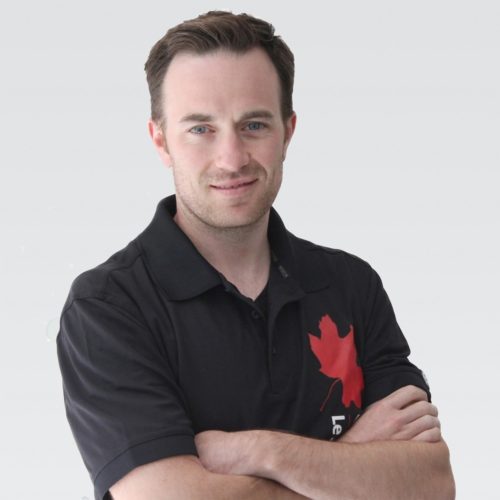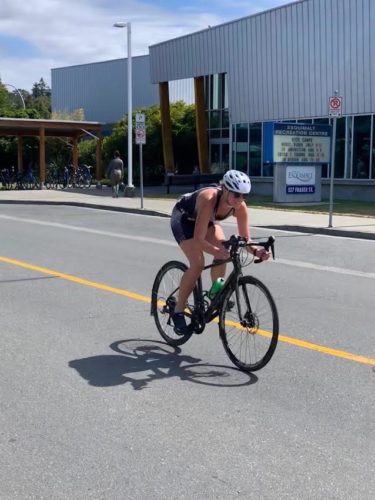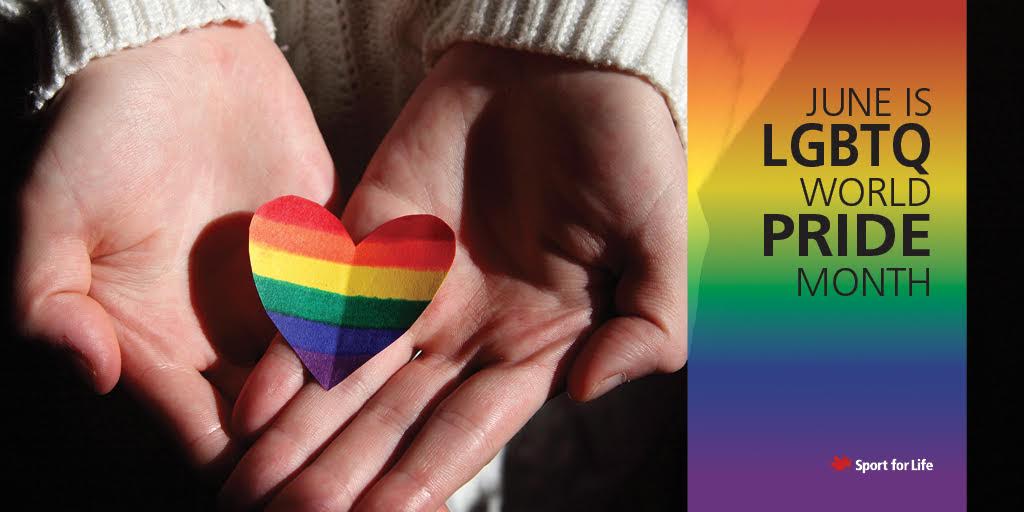Voices of Pride Month, Volume II
 Pride Month is an annual opportunity to celebrate the rich diversity of the LGBTQ+ community. Beyond the typical parades and festivities, it’s also a chance for the greater public to learn about the unique perspectives and lived experiences of people of all sexualities and gender identities.
Pride Month is an annual opportunity to celebrate the rich diversity of the LGBTQ+ community. Beyond the typical parades and festivities, it’s also a chance for the greater public to learn about the unique perspectives and lived experiences of people of all sexualities and gender identities.
This year Sport for Life reached out to various members of the LGBTQ+ community to learn about their relationship with movement and physical activity. And though this is a month of celebration, it’s also a time to acknowledge the historic and contemporary barriers that exist, and the discrimination many athletes and participants face.
This is the second of two compilations of their stories.
Nick Hastie
When Nick Hastie was a young athlete, he felt it was taboo to talk about sexuality. Nobody really engaged him on the subject of whether he was gay or not, and he didn’t offer the information. Instead he pushed himself to compete in sport at the highest level possible, hoping that his achievements would earn him a place of belonging. It wasn’t until years later, after he finished competing as a high performance triathlete and started dating a boy, that he was finally able to openly express that part of his identity.
Now that he’s working as the Senior Coordinator of Physical Literacy and and Knowledge Mobilization for Sport for Life, he’s comfortable to be his true self.
“When I was younger nobody really engaged me in the topic until after my time as a high performance athlete. At the time I felt sport allowed me to prove myself as a male, in a weird way, because I figured if I can run or skate or swim as well as any straight person then maybe I would be more respected or equal,” he said.
“When I was competing internationally in triathlon nobody was going to know my sexuality by how I ran. ‘Hey, there’s a gay guy running’. It wasn’t that I was ashamed, I just didn’t have space for it in my life. I was excited about triathlon, not boys. I also felt that I should consider politics at that level of sport, about team selections and equity and sponsorships. But after I didn’t have those pressures I grew more and more comfortable until I could say I love who I am and being gay is one part of who I am.”
 Growing up, Hastie took notice of Olympic swimmer Mark Tewksbury, who is gay. It was encouraging to see the Canadian idol bring home gold medals.
Growing up, Hastie took notice of Olympic swimmer Mark Tewksbury, who is gay. It was encouraging to see the Canadian idol bring home gold medals.
“What was really cool was he was at the top of his game. He wasn’t just gay and in sport but gay and at the top of his sport, and it made me realize that people who are gay can win medals too.”
Every year when Pride Month rolls around, Hastie is appreciative for the opportunity to celebrate with his community and appreciate how far acceptance for diverse sexualities and gender identities has come within his lifetime. In the past he’s been a member of LGBTQ+ sports teams, and has marched in the Vancouver Pride, and he’s thankful to live in a country where it can be held.
“I think it’s important that it exists, and I like that it brings various intersectionalities to it. There’s the corporatization of it, which brings a lot of visibility and scrutiny alike. There’s gay sports and lesbian this and trans that, it’s a great mindfullness opportunity to show we’re just people and we’re in all these different elements and sectors of society,” he said.
“There’s definitely a big element of it that’s just realizing how lucky we are in Vancouver to have pride for who we are and we can dance in speedos if we want to and some people can’t do that in other countries so it’s like a remembrance day every year when you realize how fortunate we are to be surrounded by mostly good people.”
That being said, Hastie feels there’s further to go when it comes to promoting inclusion in sports organizations and society as a whole, particularly with transgender athletes.
“I’m fascinated to see how this will all evolve, because there’s still so much work to do around regulations, things like changerooms, and figuring out how to include this whole group of people. I think it comes down to, when people go to a find out about sports if they’re moving to a new city or checking out a new team, even if it’s not a LGBTQ+ team there should be some mention on the website, like how businesses have a sustainability tab, it should be one of those elements that should be included in sport information,” he said.
“It could be as simple as putting something on the website or the registration page saying we accept you, or like a Pride sticker on the door of the facility. I think it’s important for sport organizations to communicate that their sport is safe for LGBTQ+ people and that should just be a standard. Then, at the provincial or national organization level, as part of their Long-Term Development framework, there should be a strategy to include LGBTQ+ athletes. We need to all be reminded or exposed to the reality that gay, lesbian and trans people will forever be joining sport and staying in sport at all levels and in all settings, so it’s important to openly message and welcome them.”
Laura Edwards
Laura Edwards didn’t come out as queer or non-binary until they were an adult, but they still found their childhood experiences with sports lonely and alienating. Even though they presented as traditionally female, participating in school sports made them feel excluded.
“In my experience of team environments, sports are rampant with homophobia. Players use LGBTQ+ people as the butt of jokes and put-downs, so rather than dealing with that I’ve always gravitated towards individual sports so I can be in charge and set my own agenda. That’s why I really like triathlon,” they told Sport for Life.

Laura Edwards
Edwards comes from a small city in Alberta, and in that environment gay and lesbian people were harshly discriminated against during their youth. Trans and non-binary people weren’t really on the social radar at the time, though Edwards remembers hearing slurs directed at people who were gender non-conforming. They think that bisexual people were particularly misunderstood, even by the queer community, because it was felt they could “blend in” or “just doing it for attention”.
“It’s only in the last 10 years or so that people have really recognized that non-binary people are real. It’s been difficult for me because I’m very invisible, very femme. People assume I’m cis and straight. Most people seem to think that to be non-binary you have to be this completely androgynous person that looks masculine and changes their name,” they said.
“When I say I’m non-binary or that I want certain pronouns, it can suck and get awkward. Every time I have to weigh the potential outcomes that may result from correcting people when they misgender me and what I think I can deal with at that moment. I have to decide if I should just let it slide and allow people to use the wrong pronouns – which I often do – or deal with potential negative reactions. I have to wonder ‘are they going to be cool or am I going to get the eye roll or the side glances or the invasive questions?’”
When it comes to sport organizations, Edwards thinks there needs to be a zero tolerance policy for discriminatory remarks, and a greater awareness about issues like pronouns.
“It feels like there’s no place for non-binary people in sports, because you’re either male or female and there’s no other categories. I found one triathlon that had a non-binary category but it meant you don’t get results so you just have to accept you can’t win,” they said.
“We could be doing more to make space for trans and non-binary people. Sports right now are automatically exclusive and that turns people away from participating. I don’t like being misgendered and put into the female category but that only gets me down X amount. For other people it’s so triggering that they can’t do the sport and be subjected to that. There should be a place for everyone in sports and right now there isn’t.”
Resources
- Canadian Center for Ethics in Sports: Sex and Gender Diversity
- Canadian Women in Sport: LGBTQI2S Inclusion in Sport Workshop
- Canadian Women in Sport: Webinars
- Egale: Resources
- Egale: Training and Workshops
- GLAAD: Sports News
- Leading the Way: Working with LGBT Athletes and Coaches
- LGBT Youthline
- LGBT Youthline: Online Resources
- LGBT Youthline: Resources
- Pride at Work: Events
- Pride at Work: Programs
- Pride at Work: Resources
- Pride Education Network: Resources
- Queer Events: Learning Resources
- Queer Events: Resources
- Queer Events: Workshops and Training
- Safer Spaces: Professional Development Workshop
- Safer Spaces: Resources
- The Federation of Gay Games
- viaSport: Adopting Inclusive Policy Language
- viaSport: Collecting Gender Identity Information
- viaSport: Creating Inclusive Environments
- viaSport: Inclusion in Sport Coaching
- viaSport: LGBTQI2S Inclusion
- viaSport: LGBTQI2S Inclusion Readiness Checklist
- viaSport: Trans Athlete Inclusion Guidelines
- YouCanPlay: Resources

